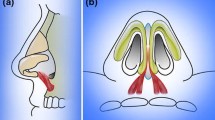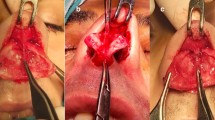Abstract
Background
Smiling causes a deformity in some rhinoplasty patients that includes drooping of the nasal tip, elevation and shortening of the upper lip, and increased maxillary gingival show. The depressor septi muscle leads this deformity. The dermocartilaginous ligament originates from the fascia of the upper third of the nose and extends down to the medial crus, merging into the depressor septi muscle.
Methods
In this study, 100 primary rhinoplasty patients were studied for hyperdynamic nasal tip ptosis. Of these patients, 36 had hyperdynamic nasal tip ptosis due to hyperactive depressor septi nasi muscle. The dermocartilaginous ligament was used as a guide to reach the depressor septi muscle in open rhinoplasty. Muscle excision was performed just below the footplates of the medial crura. A strong columellar strut graft was placed between the medial crura to avoid narrowing of the columellar width resulting from tissue excision and to withstand activation of depressor septi muscle remnants.
Results
No complications such as infection or hematoma occurred in the early postoperative period. The technique corrected the hyperdynamic nasal tip ptosis, increased upper lip length, and decreased gingival show when patients smiled. There was no narrowing of the columellar width. No depression in the columellar–labial junction due to distal resection of the depressor septi muscle was observed.
Conclusion
The dermocartilaginous ligament can be used as a reliable guide to reach the depressor septi muscle in open rhinoplasty. Therefore, the hyperactive depressor septi muscle can be definitively identified and treated without an intraoral approach.
Level of Evidence IV
This journal requires that authors assign a level of evidence to each article. For a full description of these Evidence-Based Medicine ratings, please refer to the Table of Contents or the online Instructions to Authors at www.springer.com/00266.









Similar content being viewed by others
References
Arregui JS, Elejalde MV, Regalado J, Ezquerra F, Berrazueta M (2000) Dynamic rhinoplasty for the plunging nasal tip: functional unity of the inferior third of the nose. Plast Reconstr Surg 106:1624–1629
Benlier E, Top H, Aygit AC (2005) A new approach to smiling deformity: cutting of the superior part of the orbicularis oris. Aesthet Plast Surg 29:373–377
Cachay-Velásquez H (1992) Rhinoplasty and facial expression. Ann Plast Surg 28:427–433
Cetinkale O, Tulunay S (1998) Augmentation of the columella-labial angle to prevent the “smiling deformity” in rhinoplasty. Aesthet Plast Surg 22:106–110
De Souza Pinto EB (2003) Relationship between tip nasal muscles and the short upper lip. Aesthet Plast Surg 27:381–387
De Souza Pinto EB, Da Rocha RB, Filho WQ, Neto ES, Zacharias KG, Amancio A, Braz de Camargo A (1998) Anatomy of the medial part of the septum depressor muscle in aesthetic surgery. Aesthet Plast Surg 22:111–115
Hwang K, Kim DJ, Hwang G (2006) Relationship between depressor septi nasi muscle and dermocartilaginous ligament; anatomic study and clinical application. J Craniofac Surg 17:286–290
Oh S, Kim D, Kang NH, Lee SR (2009) The muscular system of the depressor septi nasi: anatomical study and clinical application. Plast Reconstr Surg 124:101
Pitanguy I (2001) Revisiting the dermocartilaginous ligament. Plast Reconstr Surg 107:264–266
Rohrich RJ, Ghavami A (2009) Rhinoplasty for Middle Eastern noses. Plast Reconstr Surg 123:1343–1354
Rohrich RJ, Huynh B, Muzaffar AR, Adams WP Jr, Robinson JB Jr (2000) Importance of the depressor septi nasi muscle in rhinoplasty: anatomic study and clinical application. Plast Reconstr Surg 105:376–383
Rowe-Jones J, Carl van Wyk F (2010) Special considerations in northern European primary aesthetic rhinoplasty. Facial Plast Surg 26:75–85
Saban Y, Andretto Amodeo C, Hammou JC, Polselli R (2008) An anatomical study of superficial musculoaponeurotic system. Arch Facial Plast Surg 10:109–115
Author information
Authors and Affiliations
Corresponding author
Rights and permissions
About this article
Cite this article
Tellioglu, A.T., İnozu, E., Ozakpinar, R. et al. Treatment of Hyperdynamic Nasal Tip Ptosis in Open Rhinoplasty: Using the Anatomic Relationship Between the Depressor Septi Nasi Muscle and the Dermocartilaginous Ligament. Aesth Plast Surg 36, 819–826 (2012). https://doi.org/10.1007/s00266-012-9893-2
Received:
Accepted:
Published:
Issue Date:
DOI: https://doi.org/10.1007/s00266-012-9893-2




